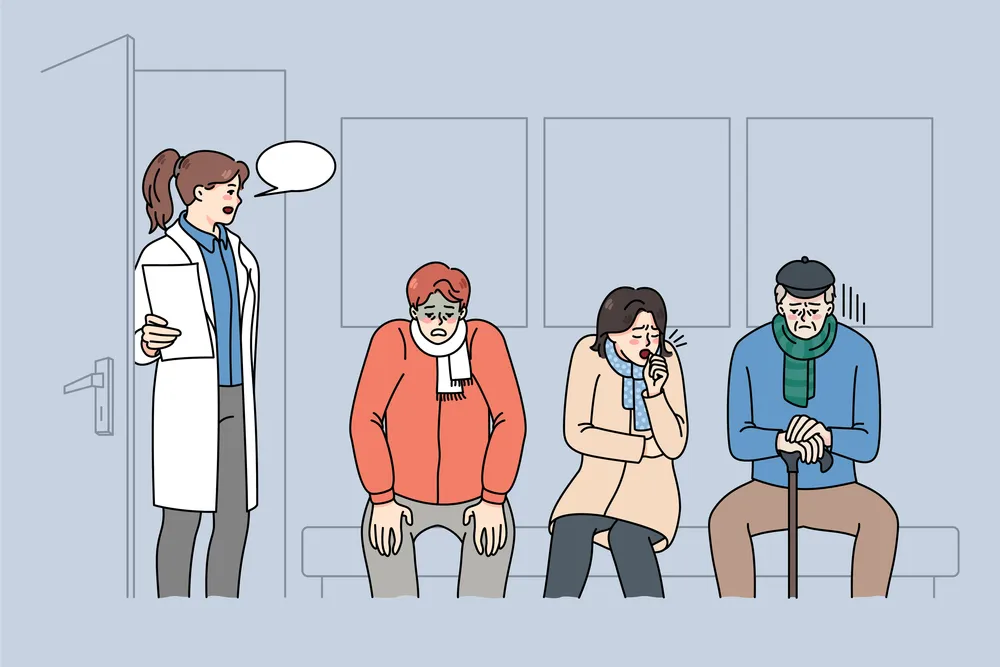With the media saturated once again with forecasts of a coming surge in COVID cases and the flu this winter, it’s perhaps no surprise that Americans overwhelmingly believe the pandemic is still with us. But they also want the government to end its COVID emergency declaration, the latest I&I/TIPP Poll shows.
In a much-discussed interview with CBS News’ 60 Minutes back in September, President Biden made the controversial comment that the pandemic “is over” in the U.S. His remarks set off a lively, and at times angry, debate.
The I&I/TIPP poll asked respondents simply, “Is the COVID pandemic over or not over?” By a slightly more than 2-to-1 margin, those answering the question said it was “not over” (60%) compared to those saying it was “over” (28%). “Not sure” trailed, coming in at 12%.
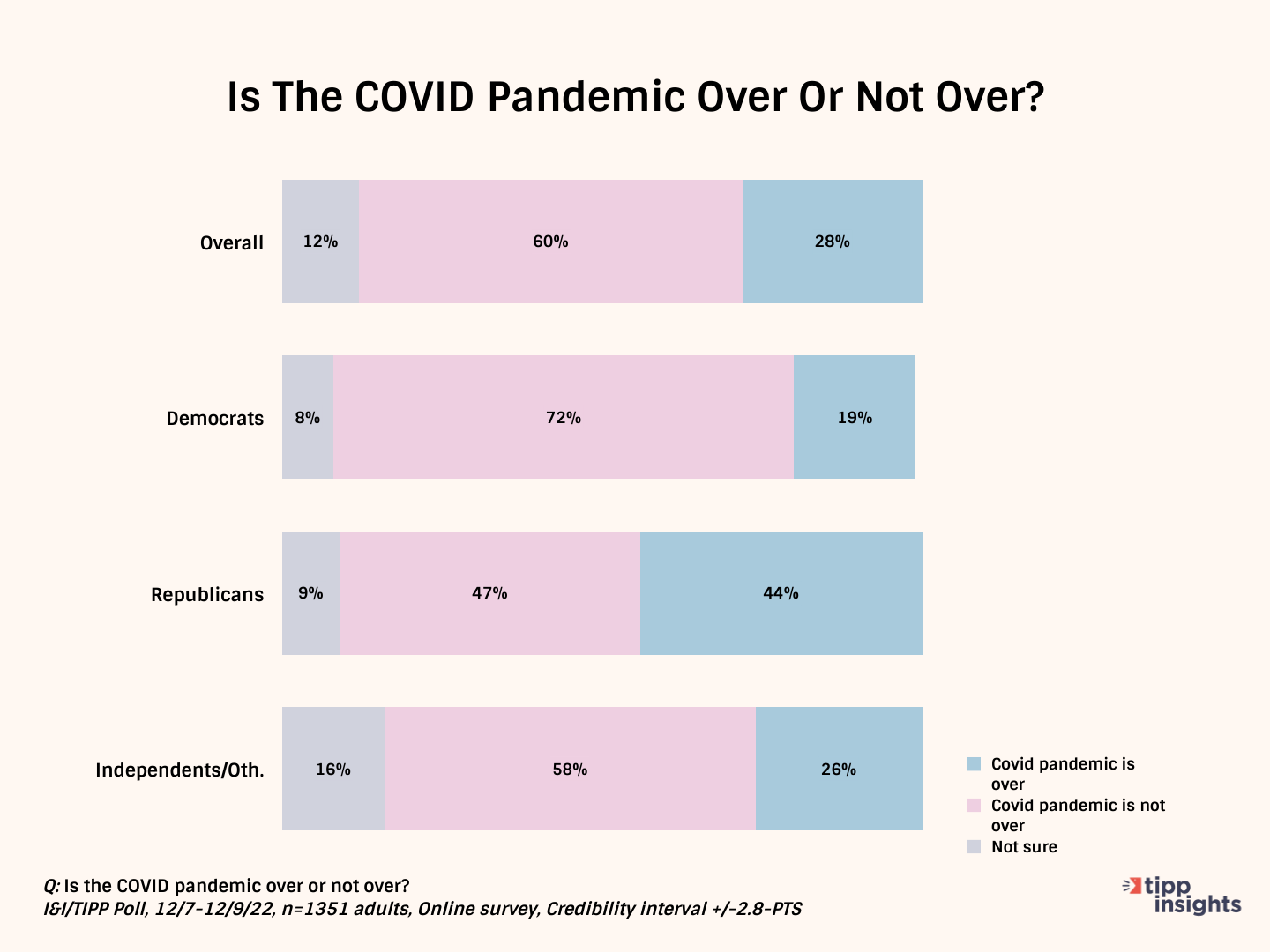
The I&I/TIPP Poll of 1,351 adults across the country was conducted online from Dec. 7-9. The poll has a margin of error of +/-2.8 percentage points.
While Republicans, at 44%, were far more likely than other political affiliations to say the pandemic is finished, that was still a minority within the GOP, with 47% saying it wasn’t over yet.
Democrats were the most convinced the pandemic wasn’t done. Only 19% of them said they believed COVID’s rampant spread was over while those answering that it was still going totaled 72%.
And, as is often the case, independents split the difference, with 26% agreeing it was over, compared to 58% saying it wasn’t.
At 34%, men were much more likely than women (22%) to say the pandemic was over. And whites (31%) were far more likely to claim it was over than blacks and Hispanics (23%).
Taken as a whole, no major demographic group felt the pandemic is over.
Even so, Americans are definitely chafing under the yoke of the government’s “emergency declaration,” used to justify mass masking policies and economic lockdowns to slow COVID’s spread.
We asked: “To what extent to you agree or disagree with the statement: the federal government should lift its COVID emergency declaration.”
Despite the majorities saying COVID was still a pandemic, a majority believe the federal government should end its emergency declaration to restore the nation to its normal footing.
Among respondents, 53% agreed that the emergency should be ended, versus 35% who disagreed. Further broken down, the data show that 24% agreed “strongly” that the emergency decree should be shut down, versus just 14% who said they “disagree strongly” with such a move.
“Disagree somewhat” (22%) compared to a roughly comparable response of “agreed somewhat” at 29%.
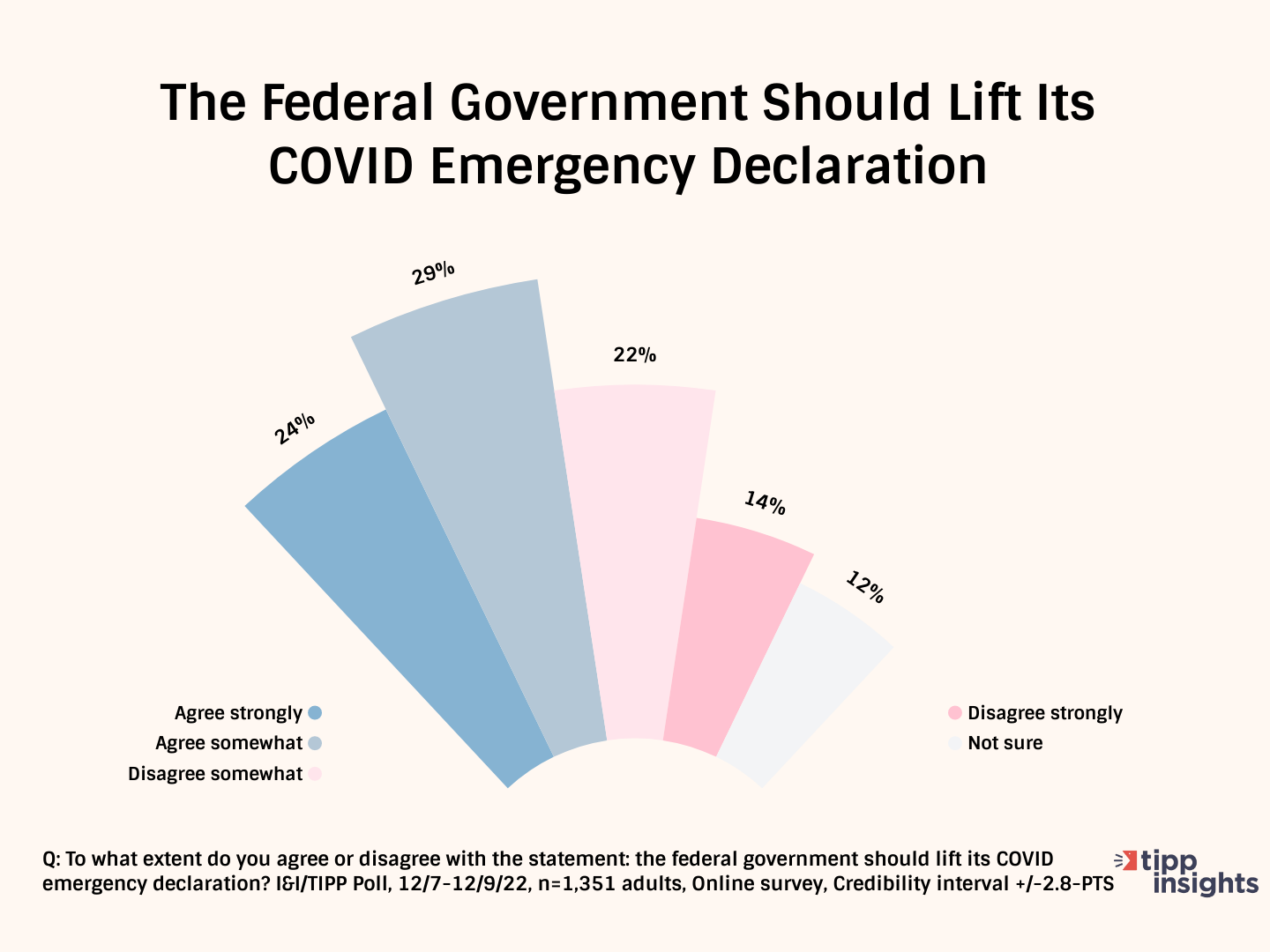
In short, not only do more people want the policy to end, but those who do seem to feel much more strongly about it.
Here again, political differences were surprisingly narrow. Among Democrats, 45% agreed the emergency should be ended, versus 46% who felt it shouldn’t. With the 2.8 percentage point margin of error, that’s a tossup.
Meanwhile, 67% of Republicans and 50% of independents wanted the emergency declaration should end, while minorities of just 23% and 33%, respectively, said keep it in place.
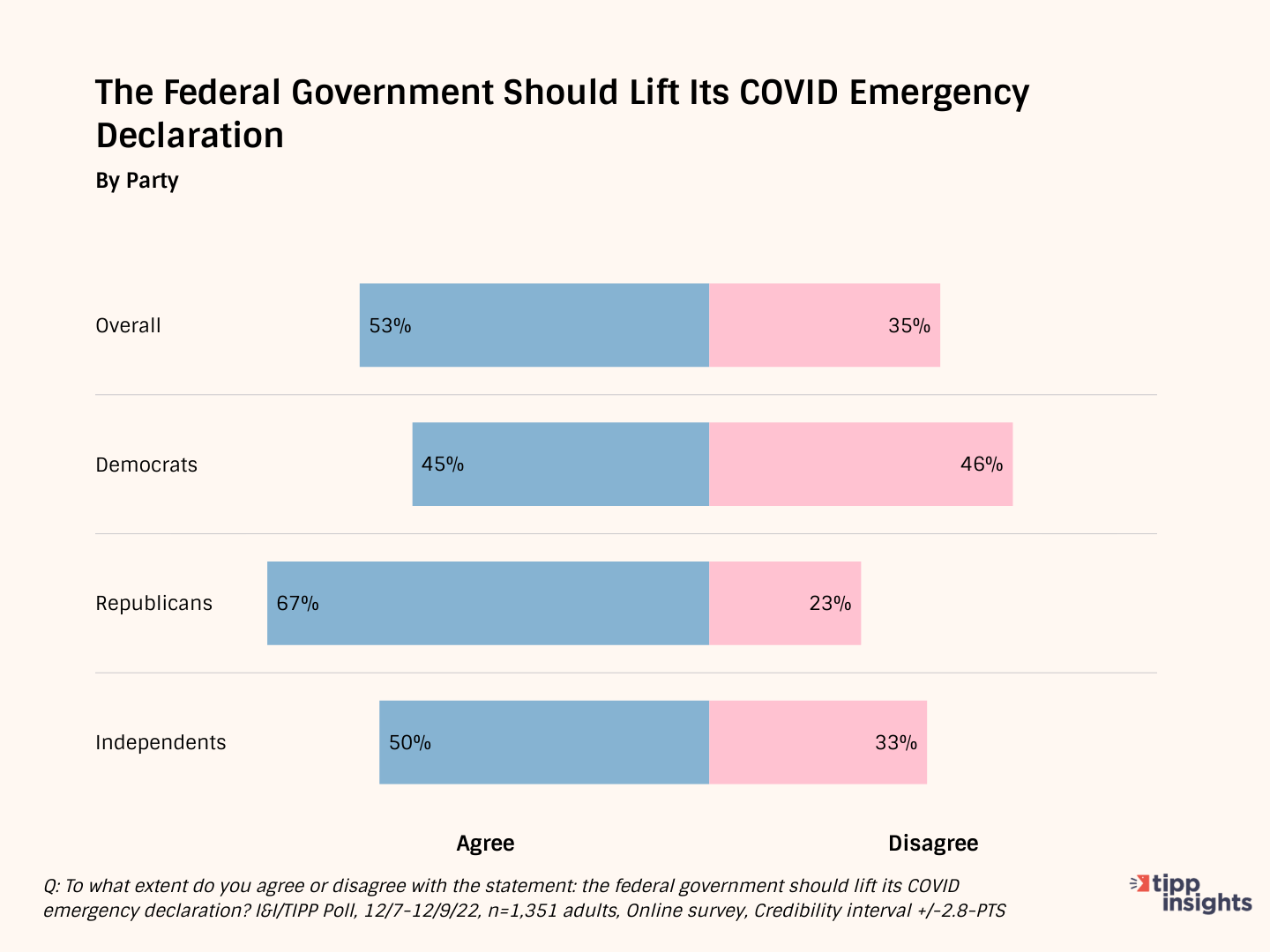
Only one major group didn’t want the emergency declaration to end: Those 65 and older, by far the group worst hit by the pandemic. By a slim 42% (agree) to 46% (disagree) margin, they said keep the emergency in place.
All other age groups saw significant majorities wanting the emergency to end: for the 18-24 year group, it was 61%. For those 25-44, it was 55%. And for those 45-54, it came in at 54%. Roughly a third of these three groups wanted the emergency to remain.
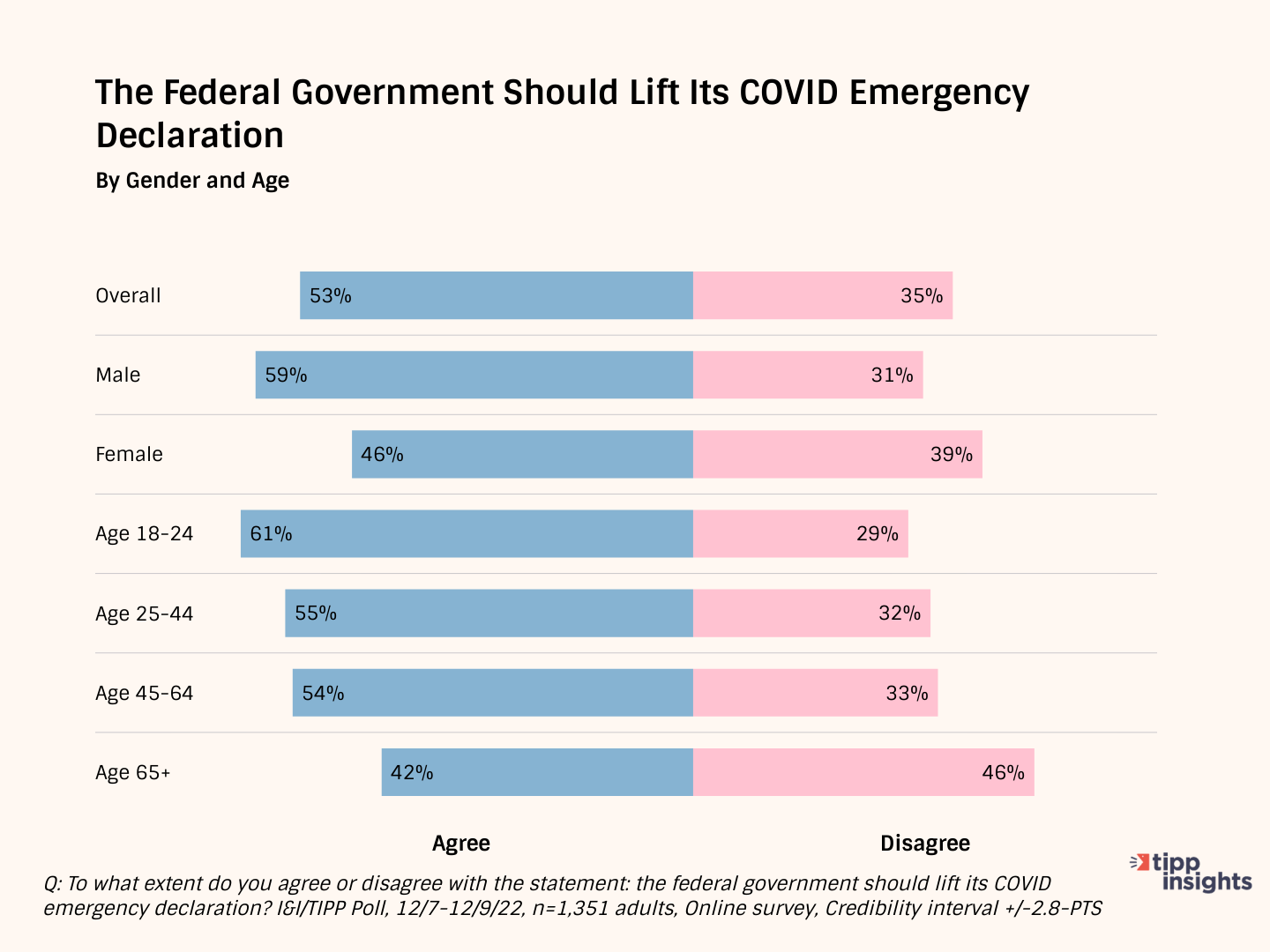
In sum, it appears that while a solid majority agree the pandemic’s still with us, they also want the lockdowns, forced masking and other emergency measures to be finished. They want, in short, normalcy.
The big question might be is the expected upsurge in new COVID cases real? Or is it just fear-driven panic, after more than a million deaths attributed to the virus? Was Biden playing up the pandemic’s end just to give Democrats a boost in the midterm elections?
The numbers don’t show it, at least not yet. A look at widely followed Johns Hopkins Coronavirus Center data show that the number of weekly cases peaked at 5.6 million in January of this year.
That number subsequently fell precipitously. For the week ending Dec. 4, 407.3 thousand cases were reported, a decline of 93% from the peak. With the cold and flu season in full swing, there’s been a slight uptick in the number of weekly cases, but no strong trend.
Meanwhile, deaths from the pandemic have likewise trended sharply downward. From a peak of 23.4 thousand weekly deaths in mid-January of 2021, the most recent week shows just 2.3 thousand deaths, a drop of 90%.
With January statistically the worst month for COVID infections and deaths over the last two years, many worry about another upsurge in early 2023. That might explain the hesitation among many in the I&I/TIPP Poll for declaring the pandemic over.
And, as always, there should be a note of caution in interpreting especially the deaths data. The government made a controversial decision in March of 2020 to count not just deaths from COVID, but deaths with COVID — a significant difference.
That led to such anomalies as people who died from gunshot wounds and car accidents being classed as COVID deaths. And co-morbidities — that is, other diseases that could have caused the death of a person with COVID — are common.
A Centers for Disease Control study found early on in the pandemic that 94% of those who died with COVID had at least one major co-morbidity.
And, “average, there were 2.6 additional conditions or causes per (COVID) death,” the report said.
Even so, CDC data show COVID as the third-leading cause of death over the last three years, behind heart disease and cancer, and just ahead of “accidents.” It looms large in Americans’ minds.
At the same time, other recent studies show that 42% of Americans have likely had COVID, though nearly half of those who did say they haven’t.
But an even-larger reason for why, even as Americans say the pandemic continues but want the emergency to end, is that both the government and media have politicized the disease.
Recent studies have raised questions over the efficacy of mRNA “vaccines” and their inherent danger to those who take them, leading to skepticism about vaccines among the public. Notable respected voices in medical research, such as Stanford University’s Dr. Jay Bhattacharya, have claimed that the “emergency declaration” and other policies that stifled debate have harmed science and the American public.
“We needed to have a discussion, an open scientific discussion about the right policies for COVID,” Bhattacharya, a co-author of the pro-science Great Barrington Declaration, said in a lengthy interview. “Imagine how different all the small businesses who stayed open, all the people that wouldn’t have missed their cancer screenings, all the kids that wouldn’t be depressed and suicidal, all the learning loss that could have been avoided if we just had an open scientific discussion.”
The recent revelations about Dr. Anthony Fauci’s familial ties to Twitter as well as ongoing questions over media bias in covering COVID have likely further undermined Americans’ trust in both government and the media.
I&I/TIPP publishes timely, unique and informative data each month on topics of public interest. TIPP reputation for polling excellence comes from being the most accurate pollster for the past five presidential elections.
Terry Jones is an editor of Issues & Insights. His four decades of journalism experience include serving as national issues editor, economics editor, and editorial page editor for Investor’s Business Daily.
Hey, want to dig deeper? Download data from our store for free!
Please email editor-tippinsights@technometrica.com

